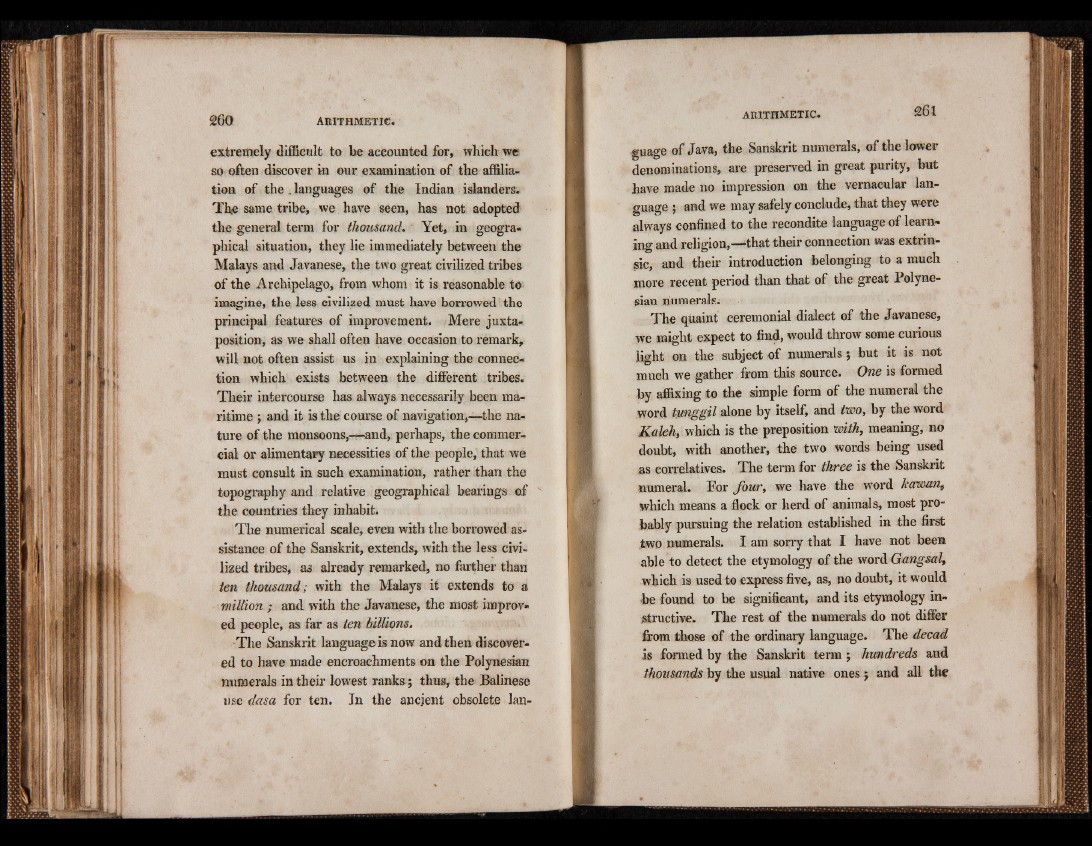
extremely difficult to be accounted for, which we
so often discover in our examination of the affiliation
of the , languages of the Indian islanders.
The same tribe, we have seen, has not adopted
the general term for thousand. Yet, in geographical
situation, they lie immediately between the
Malays and Javanese, the two great civilized tribes
of the Archipelago, from whom it is reasonable to
imagine, the less civilized must have borrowed the
principal features of improvement. Mere juxtaposition,
as we shall often have occasion to remark,
will not often assist us in explaining the connection
which exists between the different tribes.
Their intercourse has always necessarily been maritime
; and it is the course of navigation,—the nature
of the monsoons,—and, perhaps, the commercial
or alimentary necessities of the people, that we
must consult in such examination, rather than the
topography and relative geographical bearings of
the countries they inhabit.
The numerical scale, even with the borrowed assistance
of the Sanskrit, extends, with the less civilized
tribes, as already remarked, no farther than
ten thousand; with the Malays it extends to a
million ; and with the Javanese, the most improved
people, as far as ten billions.
The Sanskrit language is now and then discovered
to have made encroachments on the Polynesian
numerals in their lowest ranks; thus, the Balinese
use dasa for ten. In the ancjent obsolete language
of Java, the Sanskrit numerals, of the lower
denominations, are preserved in great purity, but
have made no impression on the vernacular language
; and we may safely conclude, that they were
always confined to the recondite language of learning
and religion,—‘that their connection was extrinsic,
and their introduction belonging to a much
more recent period than that of the great Polynesian
numerals.
The quaint ceremonial dialect of the Javanese,
we might expect to find, would throw some curious
light on the subject of numerals; but it is not
much we gather from this source. One is formed
by affixing to the simple form of the numeral the
word tmggil alone by itself, and two, by the word
Kaleh, which is the preposition with, meaning, no
doubt, with another, the two words being used
as correlatives. The term for three is the Sanskrit
numeral. For four, we have the word kawun^
which means a flock or herd of animals, most probably
pursuing the relation established in the first
two numerals. I am sorry that I have not been
able to detect the etymology of the word Gangsal,
which is used to express five, as, no doubt, it would
be found to he significant, and its etymology instructive.
The rest of the numerals do not differ
from those of the ordinary language. The decad
is formed by the Sanskrit term; hundreds and
thousands by the usual native ones ; and all the